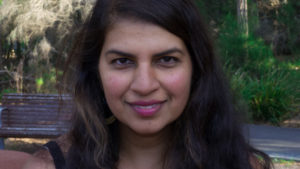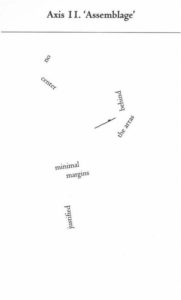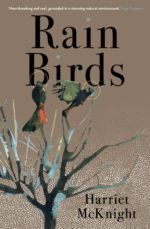The Family Circle by Kavita Nandan
 Kavita Nandan recently moved to Sydney and teaches creative writing and literature at Macquarie University. Her first novel Home after Dark was published in 2014. She is the editor of Stolen Worlds: Fijiindian Fragments. Her short stories have been published in Transnational Literature, The Island Review and Landfall.
Kavita Nandan recently moved to Sydney and teaches creative writing and literature at Macquarie University. Her first novel Home after Dark was published in 2014. She is the editor of Stolen Worlds: Fijiindian Fragments. Her short stories have been published in Transnational Literature, The Island Review and Landfall.
Photo: by Michael Kosmider
The Family Circle
Arjun steps onto the cool marble floor of the Se Cathedral. Away from the hot stickiness of the street front, he can breathe. They have cleared four tourist attractions so far, and this is to be the last for the day. A giant chandelier spills like a waterfall from the ceiling. Brass candelabras rise like stalagmites from the low altar, and above it, in a panel of the gold screen, Saint Catherine awaits martyrdom. Sublime paintings of biblical scenes suddenly turn feral on a ragged wall, throwing up his suspicion that God is more absent than present in these holy structures. A loud clatter echoes behind Arjun and he turns. His aunts sit in the pews with their digits darting into bags of salty cashew nuts and one of them, probably Aunt May, has let fall the gaudy plaster model of the Se Cathedral with a digital clock face embedded in the remaining bell tower. Bloody aunty fingers! Perspiring nephews and nieces in their ‘I love Goa’ flea market T-shirts trot in twos down the aisle. Uncles fling themselves this way and that way as if part of a dance routine, in their attempts to capture every angle of the architectural wonder. How they gushed all over the centuries-old Portuguese church like a tidal wave. Surely, only his family possessed this special talent of diminishing grandeur so completely.
At first, Arjun had ignored the summons to the reunion. But as he sat outside under a cloudless Sydney sky eating carbonara pasta in a café he liked, the email with its subject heading, ‘Reunion is the go in Goa’, revisited him. A red-tipped tailed shark of a Qantas plane, slipped away in the distance. The sky’s spectacular clarity unnerved him and a feeling of loneliness reawakened in his heart. It had been a decade since he had gone back to the country of his birth. Then, whether vision or visitation, he swore he saw his long dead grandmother, gesturing North-West with her fleshless finger from heaven. Arjun booked his flight from Sydney to Goa.
*
The family commandeer six standard rooms at an inexpensive beach resort. The aunties, who had promised their mother before she died that they would remain a close-knit family despite the geographical challenges, organised for the clan to meet, every ten years, in a different part of India. On this occasion, May, Maggie, June and Preeti bubbled with moral superiority at the absence of the two elder sisters who lived in the UK and Australia. At least, they consoled themselves with exaggerated sighs, their strange children, with their Indian faces but foreign accents and values had come from overseas.
Jetlagged, Arjun, and his cousin Arti and her husband who have come from London, go to bed early. The domestic travellers settle in industriously, putting clothes away in cupboards, storing cooked food and snacks brought from home in the mini fridges, scolding the children for turning the ceiling fan on and off, pressing the buttons of the TV remote control at random, juggling ornaments and stabbing at the fruit pyramid gleefully.
The next morning, Maggie, dressed in a floral-patterned kaftan, is jubilant that consensus has been achieved: all 16 of them are visiting the Spice Plantation. A keen cook, she savours the aroma of vanilla, then cinnamon, then cardamom. Andrew, her son, excavates his nose with a grubby finger and retracting it says, “Look ma, spice!”
Arjun grins to himself. Obnoxious kid. Then a glimpse of a scarf the colour of kingfisher blue. He remembers that afternoon in Uncle Joseph’s and Aunt May’s bedroom – the first and only time Lara and he were together – how carefully she had placed her scarf on the side-table as if it was a fledgling bird. His cousin Lara darts through the spice trees chasing after her own child.
The guide leads them though the leafy green plantation, stopping often to point out the different spices and tropical trees. He hands out bananas and star fruit to the kids to soften their boredom.
Like the others, Arjun tries what’s on offer but he is not satisfied. He remembers this gnawing sense of want, of wanting more, from his year spent staying with his Aunties in his twenties. For a moment, he thinks back to those nights he smoked hash on his Uncle’s and Aunt’s terrace and how he’d stare up at the night sky, smeared with stars, seeing a portal warbling between a familiar and an unknown world. Always, Lara, there, by his side. Squeezing his hand. Back then, they’d thought fuck parents, fuck the establishment . . . fuck making money when the family already had enough to see them through to kingdom come. Now, he can’t get to that state of being high with a pre-party Ecstasy tab or hit of LSD.
*
One of the twins’ stuffs a handful of black pepper into his mouth and yells for a straight five minutes. The little potbelly of the other twin is convulsing with shrieking laughter as Aunt May skips and hops and scolds.
After the plantation excursion, the family return to the hotel restaurant for an early dinner. Light-hearted banter between family members soon turns personal and vicious.
Maggie, his mother’s sister reaches for two of the extra-large Goan chapatis, and looking first at May, then at the chapati pile again, says “The twins have grown fat, May, but poor little Bunty . . . is he not getting enough food? Look at him. Thin as a bhindee.”
May like a snake provoked, bites immediately, “Andrew has become very naughty, don’t you think? And his sister seems a little behind at school. I hope she doesn’t have to repeat class four.”
“Arjun, are you losing your hair?” Asks Uncle Harry as he runs his hand through his own, then repeats the gesture. “Pity your parents couldn’t make it. They always seem to be going to some overseas conference. Intellectuals eh?”
The bastard, Arjun thinks. He wouldn’t have minded so much about the hair comment if Lara, still cold as hell towards him, wasn’t in earshot.
Uncle Rai slurring and slurping his third glass of Feni begins his worn-out tirade: “It was Maggie’s butter chicken that finally killed the old bird. She knew Mummy’s doctor had expressly forbidden rich foods.” Maggie’s fingers are greasy and flakes of chapati are all over her lap, but Arjun can see her left ankle beginning to shake and he wants to stride across the room and slap his uncle for being such a patriarchal jerk.
Uncle Rai can’t stop himself: “So Maggie, I suppose it’s all decided now that the kids are going to private schools?”
“Rai! It was in our mother’s will that we get the house. We did spend a lot of time with her after you and June moved to Chennai.”
“Maggie!” June says heatedly, “You know we moved to be closer to Rai’s family after his father had the triple bypass.”
Aunt Preeti, who had been listening silently to the conversation up to this point, explodes like corn kernels hitting hot oil, one after the other. “YOU. ARE. ALL. OBSESSED. DID. ANY. OF. YOU. CARE. WHEN. MY. HUSBAND. WAS. DYING!”
Aunt May, red faced and perspiring replies, “Preeti, you never did see the value of money.”
“That’s why we all pay for her now!” shouts Uncle Joseph from the opposite end of the table.
“What an ass,” Arti mutters under her breath to her husband. Mark hurriedly hides the sucked curried prawns on his plate under the serviette, conscious that he might have taken too many.
Why do they bother? Arjun thinks. It’s as if the weeks of goodwill it took to work out the logistics for every family member coming from Delhi, Mumbai, Chennai and Bangalore and as far away as Sydney and London, and meeting in one spot – Goa – had only pushed their divisive emotions underground temporarily. They toured the churches, the beaches, the plantations, the markets together, but seemed only vaguely interested in the attractions themselves, and only too willing to argue at every turn. A gap of ten years was a reasonable time to expect quarrels to be forgiven if not forgotten, but neither seemed to be the case. The family’s differences were returning like resurrection plants.
Maybe his cynicism came from his lack of innocence. Since nobody had committed murder within the family yet, he was probably the biggest deviant here. Though sleeping with his first cousin had felt. . . inevitable. . . for both of them.
Knowing that the year was almost up and he would be returning to Australia to start an MBA had made him daring and insanely horny. Lara had been willing, flirty and in unison they had drunk several whiskey gulps from Uncle Joseph’s liquor stash kept in his cupboard that he thought no one knew about. Three days later, he had left.
It was almost annoying how she gave nothing away, no secret looks in his direction or holding his gaze a little longer than necessary. She was behaving as if nothing had ever happened between them and seemed completely engrossed in the child. Since when did Lara have a child? He regretted now that he never hit send on that email he wrote to her. On all those emails he wrote her. What kind of an insensitive bastard was he? He had only thought of his own embarrassment.
Lara yanks back the pallu of her sari from Max who is gripping it with both hands and using it to slide around the room. Then she cuddles the boy and gives him a piece of papaya.
He needs her to look at him. He remembers the diffused, sexiness of her eyes like she was either tipsy or in a state of desire that she used to have. He feels guilty for wanting her, again. Christ. He’s nearly thirty-five, surely . . . He thinks of Michelle back home redecorating their small Sydney apartment so they might sell it and buy a house, start a family.
Lara grips the knife she is using to cut up the papaya and turns to him, transforming into Kali, the goddess of death, with human heads around her neck and arms of men in a girdle around her waist.
He knows then that he’s terribly wrong: of course she remembers and hasn’t even come close to forgiving him. Max is sticking out his orange-Fanta tongue at him.
The family spend the next day at the beach. They encircle three tables joined together in a beach shack. They are practically hijacking the place with their sheer numbers. But then he remembers this isn’t Darlinghurst. The waiters gossip amongst themselves in Konkani. His uncles consume bottles of local Kingfisher beer, except for Uncle Rai who is silently reading a philosophical tract at the table and avoiding everyone’s eyes, especially Maggie’s, after the insults of yesterday.
Boney M and Michael Jackson interspersed with Indian movie hits spin around the room, escape outside, tumble and disappear into radiant waves.
His aunts are chatting with each other and laughing as if they have forgotten the angry things that were said to each other the day before. Aunt Preeti, however, is sitting apart, on a deck chair. She wears her hair in a stylish knot under her European-styled hat and the leg of her salwar billows in the wind. A young man prances on a jet ski in gold speedos near the seashore. Arjun sees that his aunt is older and sadder but still beautiful like her daughter Lara.
The men, having eaten and drunk too much at lunch, lie like overcooked lobsters in deck chairs on the beach and the women fret about the kids drowning and what to prepare for the next meal. They pass the usual comments about the tourists being too fat, too skinny and too liberal. When a topless woman walks past them, Aunt May does not have enough hands to cover all three sets of eyes of her unruly boys. When she realises that the woman in the white triangle barely covering her private parts is her niece, Arti, her hands drop, enabling her sons to get an eyeful.
The next morning, Arjun wakes up before the others to go sightseeing on his own. Walking around the seventeenth century church, he looks at the revered statues of Saint Francis of Assisi, Saint Peter and Saint Paul and remains unmoved. The broken body of Jesus on the Cross, however, strikes a chord. All those years of going to church and reading the bible to please his grandmother, what did they amount to? He feels regret at all the wasted Sunday mornings at bible study, but not a lot, too much time has passed.
He finds Sonya, Aunt June’s and Uncle Rai’s grandchild, sitting on a pew, head bent deep in concentration. Perhaps like him, she had wanted some time alone. Sonya is sketching something on a large notebook. He sits silently behind her, taking a peek over her shoulder, which is newly branded with a thick white stripe from yesterday’s swim. She is drawing a caricature of Jesus on the Cross. Her Jesus looks a lot like Uncle Harry, the family’s only politician and self-proclaimed martyr. He wishes he’d been that savvy at her age.
At the Bom Basilica, he stops several times to take photographs for Michelle. Photos were the only thing she asked for apart from some Goan silk, ‘preferably in marigold yellow, beaded along the edges and large enough to cover a Queen sized bed.’
“Arjun,” she had asked while she was chipping away at the tiles in the splashback, “is the real reason you don’t want me to come that you are ashamed of me?”
Why does she walk like a giraffe? Arree, her clothes are so drab. She should close her mouth when she smiles – her teeth are too big, don’t you think? How could he explain to her that his family would find fault in everything he loved about her. So instead he offered no explanation at all and reiterated that of course he wasn’t ashamed of her. When he discovers extra pairs of underwear and sunscreen in his suitcase, he knows that this is Michelle’s way of forgiving him.
He notices Mark, Arti’s husband, up ahead talking to a dark and pretty Goanese girl. It is the waitress who served them yesterday at the beach shack. He sees Mark touch the girl’s arm and he strides forward, not willing to wait for something more to happen as it does so easily in this hot and fleshy city, when he hears a sudden braking followed by a series of skids, a loud bang and waves of screaming.
As he turns around, the crowd rushes past him leaving him isolated on a square of concrete, dwarfed in front of the great church with the heat piercing his brain like a bullet.
He can hear Mark’s voice, dream-like, as he runs past in the same direction: “Shit man, are you coming?” The crowd is forming a circle on the road up ahead.
Arjun is standing by Mark now who looks unsure of himself. He grabs Mark’s arm to steady him, but when it looks like Mark is about to spew, he shoves him away.
A person lies under a vehicle with his knees facing upwards. It almost seems as if he is repairing the bus. But why would he be doing that in the middle of the road? And holding up all this traffic? Now that he looks more closely the legs are remarkably still. He starts to notice, even though he doesn’t want to, other things like the paleness of the legs, the tattoo of a tribal lion covering a large area of thigh and one bright red flip flop still clinging to a foot.
The bus driver is sitting in his seat, his eyes darting everywhere and sweat running down his face like monsoonal rain. Soon they are surrounded by noises and activity: ambulance sirens blaring, cars screeching to a halt, doors being slammed, and policemen running about dispersing the unheeding crowd. The commotion dies down and some people within the circle leave, satisfied that they are abreast of the latest in Goa. They are easily replaced by others whose curiosity is yet to be satiated.
“Some poor foreigner,” Mark says in a hopelessly Scottish accent.
Arjun looks down at his shaking hands and legs. As he raises his head again he sees familiar faces interspersed in the crowd. Maggie is standing next to Rai and June next to Harry as if they have swapped husbands. Joseph picks up Preeti’s hat that has fallen on the road and gives it to her. May’s three boys are holding hands and Lara is covering her child’s eyes with the pallu of her sari and waving. It seems as if the whole family are there, looking through the multitudes and smiling tenderly at him.
As the ambulance workers are piling the foreigner onto the stretcher as they might a dead body, the bloodied and broken corpse sits up. The crowd gasps collectively, cheers collectively.
Arjun trembles as the ring of people holds fast, then breaks, and breaks again.
 AXIS Book I: ‘Areal’
AXIS Book I: ‘Areal’
 Claire Albrecht is writing her PhD in Poetry at the University of Newcastle. Her current work investigates the connections between poetry/photography and sex/politics. Claire’s poems appear in Cordite Poetry Review, Overland Literary Journal, Plumwood Mountain, The Suburban Review and elsewhere. Her manuscript sediment was shortlisted for the 2018 Subbed In chapbook prize, and the poem ‘mindfulness’ won the Secret Spaces prize. Her debut chapbook
Claire Albrecht is writing her PhD in Poetry at the University of Newcastle. Her current work investigates the connections between poetry/photography and sex/politics. Claire’s poems appear in Cordite Poetry Review, Overland Literary Journal, Plumwood Mountain, The Suburban Review and elsewhere. Her manuscript sediment was shortlisted for the 2018 Subbed In chapbook prize, and the poem ‘mindfulness’ won the Secret Spaces prize. Her debut chapbook  Autumn Royal is a poet and researcher. Autumn’s poetry and criticism have appeared in publications such as Contemporary Australian Feminist Poetry, Overland Literary Journal, Southerly Journal and TEXT Journal. She is interviews editor for Cordite Poetry Review and author of the poetry collection She Woke & Rose. Autumn’s second collection of poetry is forthcoming with Giramondo Publishing.
Autumn Royal is a poet and researcher. Autumn’s poetry and criticism have appeared in publications such as Contemporary Australian Feminist Poetry, Overland Literary Journal, Southerly Journal and TEXT Journal. She is interviews editor for Cordite Poetry Review and author of the poetry collection She Woke & Rose. Autumn’s second collection of poetry is forthcoming with Giramondo Publishing. The Book of Thistles
The Book of Thistles  Rain Birds
Rain Birds
 David Adès
David Adès Journey to Horseshoe Bend
Journey to Horseshoe Bend The Measure of Skin
The Measure of Skin